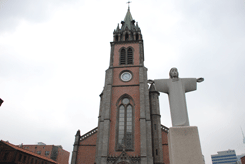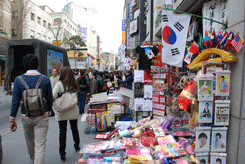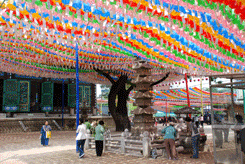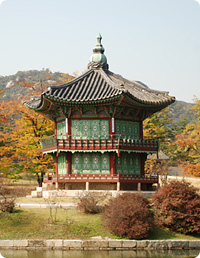DAY
Churches and Temples / 7 hours



Tour Highlights
- Myeongdong Cathedral
- Insadong
- Jogyesa Temple
- Gyeongbokgung Palace
- National Folklore Museum
- Seoul Cathedral Anglican Church of Korea
Seoul (- - -)
This morning, you will discover the unique surprises in the fascinating city of contrast and get an introduction to a wonderful mix of interesting architecture, with old and new jostling for peace in this mega-metropolis. Your exploration involves a considerable amount of walk. Myeongdong Cathedral is one of the holiest Catholic grounds in Korea. Although Buddhism have flourished over the centuries, Korea has a strong representation of Catholics and the Myeong-dong Cathedral is perhaps the most recognizable symbol of the faith in the country, marking the Korea's first Gothic building and an important milestone in the country's architectural history as well.
You will pass by Cheonggyecheon Stream. After the Korean War (1950-1953), more people migrated into Seoul to make their living and settled down along the stream in shabby makeshift houses. The accompanying trash and waste, and deteriorating conditions resulted in an eyesore for the city. The stream was covered with layers of concrete in the mid 1950s and roadway until the massive urban renewal project freed it in 2005. Today, a 5.8km creek tumbles gently through downtown Seoul, providing a much needed source of peace and relaxation for the citizens of this fast-paced city. You may have a chance to view the sculpture standing tall at the head of the stream on a small plaza. Created by Dutch artist Coosje Van Bruggen and Swedish artist Claes Oldenburg, a shell rising upward like pagoda symbolizes new life.
Insadong, at one time the center of traditional Korean art and antiques, features a mixture of historical and modern atmosphere representing the cultural glimpse of the nation. Clustered along the main street and alleys are lined with street vendors, wooden tea houses, restaurants and numerous galleries and shops dealing in antiques, oriental art supplies, and modern Korean art of all types and styles. Soak in the paintings, upscale artworks, antiques and potteries while you can. Get lucky and you just might meet the artist themselves. It can be plenty of fun walking on the main street, but you venture into the hidden alleys that do spring some unexpected surprises. While here, you may want to buy some souvenirs or simply wander and browse at leisure admiring cultural ambience.
Squeeze in a stop at Jogyesa, the head temple of Jogyejong the principal sect of Korean Buddhism, emphasizing the Zen orthodox, meditation tradition and the purity of monastic celibacy. The temple does not give off the solemn and traditional air of the other temples located deep in the mountains, but when you enter the temple the frenzy of the city start disappearing. The Main Worship Hall holds triad Buddhas, Sakyamuni, Amitabha and Bhaisajyaraja. The figure in the center is Sakyamuni Buddha who has overcome greed, hatred and delusion. While here it is worth noting the 500 year old lacebark pine and 400 year old locust tree that still grace the property.
Step back in time to when life was gracefully slow and discover Gyeongbokgung Palace, a particularly charming spot that represents a colorful and turbulent side of the capital's 500-year history. Depending on timing, you may witness the Royal Guard Changing Ceremony featuring parade, password verification, duty shift and patrolling the gate. Accompanied by a court band with its colorful costumes and royal flags, the ceremony is performed daily basis at 10:00 and 14:00 except Tuesdays, although it is cancelled in case of rain or extremely hot or cold weather.
Up from the gates is a spacious stone-paved courtyard that is fully enclosed by wooden cloisters, and at the center of which runs three footpaths through two rows of rank stones, indicating the positions of the officials with the highest rank being closer to the hall.
Standing majestically on top of a two-tiered stone platform that is lined with detailed balustrades is Geunjeongjeon Hall, where the king formally granted audiences to his officials, gave declarations of national importance, presided over large official functions, and greeted foreign envoys and ambassadors. Check out the royal throne and a large painting, depicting sun, moon, five peaks, streams and pine trees, which was the crucial signifier of the king. And up in the center of the ceiling, the bright golden dragons in bold relief indicate the presence of the king.
At the back of the throne hall is a group of court offices. Displayed in front of the King's official quarters is sundial, conceived in order to catch the shadow of the sun, which tells time and 24 periods of seasonal change from the winter solstice to the summer solstice.
Sitting on the island in the rectangular lake is Gyeonghoeru. Supported by 48 square and cylindrical massive stone pillars representing the idea of Yin and Yang, this magnificent pavilion was used for many purposes ranging from receptions to national examinations.
Gangnyeongjeon is the king's sleeping and living quarters while Gyotaejeon is the queen's domain containing a number of halls. The noted feature of these main buildings is an absence of a top roof ridge.
Amisan Garden, landscaped with four hexagonal chimneys in orange bricks, is seldom noticed by the hurried visitors. Jagyeongjeon is the queen dowager's residence. Although less colorful, it is worth noting the wall, adorned with floral designs and the chimneys with ten longevity symbols.
Hyangwonjeong features a small pond with a manmade islet that supports a beautiful two-story pavilion. Behind this serene garden is Geoncheonggung, where the king and queen could relax in peace and quiet. It was here that the first electric lights in the country were installed in 1887 in 9 years of Thomas Edison's invention and a tragic chapter in Korea's history was recorded when empress Myeongseong was assassinated by the sword-bearing Japanese assassins in the early morning of 8 October 1895, allegedly under orders from Miura Goro.
Your visit to the National Folk Museum of Korea will familiarize you with wealthy culture of this friendly and picturesque nation. It is an excellent facility to illustrate the history of traditional life of the Korean people from the prehistoric age to the Joseon dynasty. The permanent exhibition features life and work, costumes and ornaments, handicrafts and technology, educations, living quarters, dietary life, oriental medicine, performing arts and games, beliefs and rituals, and
socio cultural life.
Drive past Gwanghwamun Plaza with its statue of Yi Sunsin, who had engaged in twenty-three naval battles against Japan and emerged victorious in all of them during the Hideyoshi invasion (1592-1598). King Sejong who propagated the Korean alphabet in the 15th century is also honored with prominent statue. It was here on August 16, 2014, Pope Francis celebrated Mass in this plaza to beatify 124 Korean martyrs.
Tour also includes Orthodox Church St. Nicholas Cathedral. In July 1897 the Russian Orthodox Church missionaries to Korea by decision of the Holy Synod Archimandrite Ambrose Gountko was refused permission to enter the country.
In 1900, a missionary team led by Archimandrite Chrysanthos Shehtkofsky to begin an outreach.
With the Japanese occupation of Korea from 1910 to 1945 came an intense period of persecution against Orthodox Christian believers.
In November 1921, the Holy Synod of the Patriarchate of Moscow ended its support of the Church of Korea, and the Japanese Orthodox Church gave up its jurisdictional authority. Thus, in 1946, the Orthodox Church of Korea was placed into the position of having to organize itself as a parish.
However, in 1953, Army Chaplain Archimandrite Andrew Halkiopoulos of the Military Forces of Greece became aware of the Korean Orthodox faithful and arranged for the parish in Seoul to be reestablished.
Then, on Christmas Eve of 1955, by unanimous decision, the Korean Orthodox community chose formally to come under the jurisdictional authority of the Ecumenical Patriarchate of Constantinople.






